View full image
Canberra and the Griffins
Before Federation, intense rivalry between the colonies of New South Wales and Victoria made the location of the new federal capital a contentious issue. A compromise was struck and written into section 125 of the Constitution: the capital would be in New South Wales, but ‘distant not less than 100 miles from Sydney’. Until it could meet in the new capital, the Federal Parliament would sit in Melbourne.1 Years of investigation and debate (including two Royal Commissions) followed until the Yass-Queanbeyan district was chosen in 1908.2
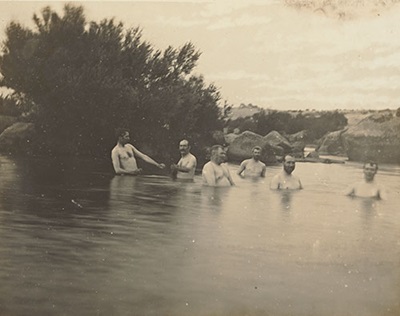
Edmund Thomas Luke (1864-1938), Senators bathing in the Snowy River at Dalgety, 1902. Courtesy of the National Library of Australia, nla.obj-140785832.
This photograph shows senators visiting Dalgety in 1902 while investigating possible sites for the federal capital.
An area within 17 miles of Dalgety was selected under the Seat of Government Act 1904.3 However, Dalgety was unacceptable to the NSW Government due to its proximity to Victoria.4 The Act was repealed in 1908 when legislation passed designating the Yass-Queanbeyan district as the site.

Theodore Penleigh Boyd (1890-1923), The Federal Capital Site, Canberra, 1913, Historic Memorials Collection, Parliament House Art Collections.
The federal government took control of the new territory in 1911 and quickly announced an international design competition for the new city. In 1912, a design submitted by US architects Walter Burley Griffin and Marion Mahony Griffin was declared the winner.
The Griffins relocated to Australia to oversee the detailed planning and produce their ‘final design’.5 However, budget constraints, bureaucratic obstacles, and the outbreak of World War I saw their vision only partially realised, and they left Canberra in 1920.6

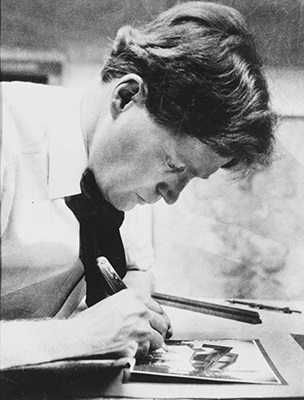
Marion Mahony Griffin and Walter Burley Griffin gardening in the backyard of "Pholiota", Heidelberg, Victoria, 1918. Courtesy of the National Library of Australia PIC Box PS 3265 #PIC/P490/7; Australian News and Information Bureau Canberra, Portrait of architect Walter Burley Griffin,1925. Courtesy of the National Archives of Australia A1200, L32618.
Yet the Griffin legacy remains throughout Canberra, with their design principles creating a city integrated with the landscape through interconnected built and natural environments.
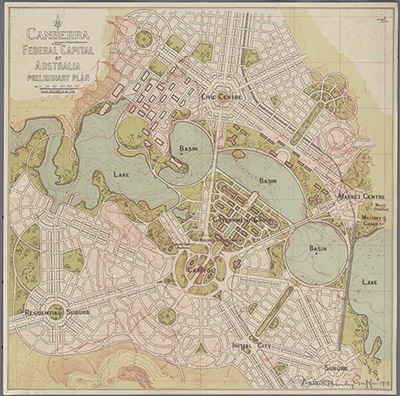
Walter Burley Griffin (1876-1937), Canberra Federal Capital of Australia preliminary plan, 1913. Courtesy of the National Library of Australia, nla.obj-230041959.
The competition brief asked entrants ‘to embody in their Designs all recent developments in the science of town planning’, befitting what will be ‘the official and social centre of Australia’.7
In Canberra, the order of the city grew from the poetic interpretation of Walter Burley Griffin, on a site genially selected by a group of citizens and public servants who had that same vision. The plan of Canberra is an artistic plan developed by creating sensitive relationships between hills and valleys, itineraries and distant views, vegetation and architecture. Directions and alignments were established with the help of a geometry always inscribed through the boundaries of the natural settings.
Romaldo Giurgola, 1988
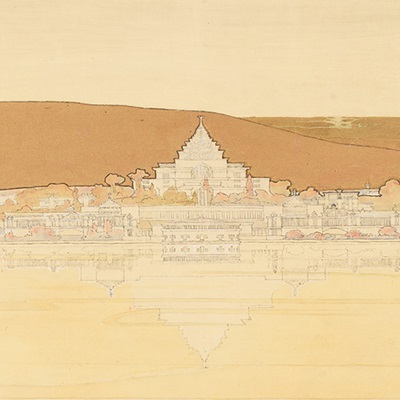
Walter Burley Griffin (1876-1937), Marion Mahony Griffin (1871-1961), Detail from Griffin’s plan for Canberra, showing the Capitol building as a stepped pyramid. Courtesy of the National Archives of Australia, A 710.43.
Laying the foundation stone of the Capitol
The souvenir was designed … to convey an idea of the richness of the resources of the Commonwealth and no polish or stain were necessary to exaggerate the true colours and variation of the timbers, of which over fifty different varieties were used.8
Walter Burley Griffin
In the Griffin’s design plans, Parliament House was to be at the foot of Camp Hill. Above, on Capital Hill was the proposed location of the Capitol building, intended for ‘popular assembly and festivity rather than deliberation and counsel’.9 In 1920, His Royal Highness the Prince of Wales, later King Edward VIII, laid the Capitol’s foundation stone on the summit of the hill. Instead of a trowel, Walter Burley Griffin designed a mallet (and storage casket), to be used for the ceremony as it was ‘more appropriate to the character of the Capitol foundation stone’.
Made exclusively of Australian timbers,10 the mallet and casket were presented to the Prince of Wales during the ceremony but returned to Australia in 1949.11
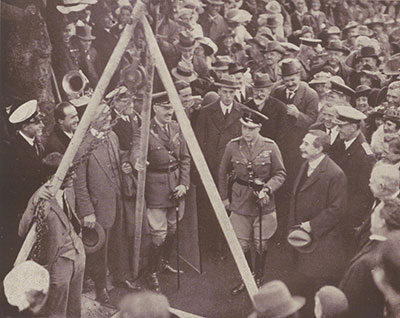
His Majesty The Prince of Wales holding the mallet as the foundation stone is lowered in place, Capitol Hill, Canberra, 1920. Reproduced in A Century of Journalism: The Sydney Morning Herald & Its Record of Australian Life 1831-1931, John Fairfax & Sons Ltd, Sydney, 1931 p. 418.
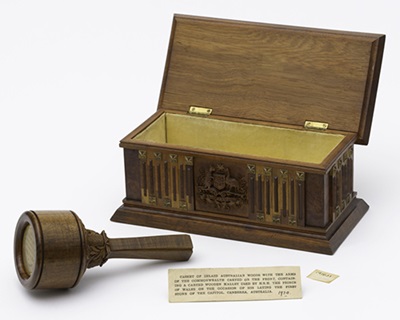
Walter Burley Griffin (1876-1937), N Redding, H. Goldman Manufacturing Co. (1911-1927), Mallet and casket used by Prince of Wales when laying foundation stone on Capital Hill in 1920, circa 1920, Official Gifts Collection, Parliament House Art Collections.
The six panels on the sides of the casket represent each state and are made with different timbers that are native to that local area. These include: Myall (SA), Blackwood (VIC, SA, TAS), Jamwood (WA), Silver Wattle (VIC), Sassafras (TAS), Coast Honeysuckle (VIC), Western Honeysuckle (WA), She Oak (NSW), Western She Oak (WA), Black Bean (QLD), Cedar (QLD), Queensland Black Walnut (QLD), Rosewood (QLD), Red Bean (QLD), Red Gum (WA), Yate (WA), Mallee (SA), Karri (WA), Blue Gum (TAS), Tooart (WA), Red Mountain Ash (NSW), Morrell (WA), York Gum (WA), Red Stringy Bark (SA), Jarrah (WA), Yellow Box (VIC), Yellow Stringy Bark (VIC), Messmate (VIC, SA and TAS)), Red Box (NSW), Peppermint (NSW), Red Gum (SA), Wandoo (WA), White Mountain Ash (VIC), Swamp Mahogony (NSW), Salmon Gum (WA), Native Cherry (NSW), Myrtle Beech (TAS), Queensland Maple (QLD), Silky Oak (QLD), Needlewood (NSW and SA), Musk (TAS), Celery Top Pine (TAS), Hazel (VIC), Mint Tree (VIC) Sandalwood (VIC), Fragrant Sandalwood (WA), Crowsfoot Elm (QLD), Kanuka (QLD) and Native Pear (WA).
Pink Myrtle Beech (TAS) is used on the base and Black Bean (QLD) wood for the lid.

Printed card designed by Griffin as a reference for the Australian timbers included on the casket, 1920. Courtey of the National Archives of Australia A199, FC1921/759.
The Griffins’ vision for a Capitol building was never realised.12 Instead, in 1974, the Australian Parliament selected Capital Hill as the site of the new Parliament House. In 1985, the then Prince and Princess of Wales re-laid the Capitol’s foundation stone in the Queen’s Terrace on Level 1 of Parliament House.
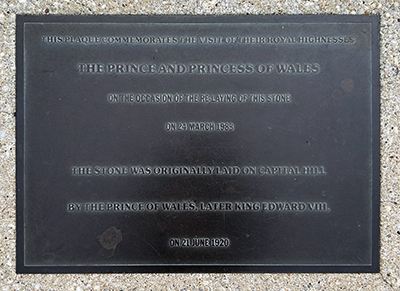
The bronze plaque on Queens Terrace commemorating the visit of their Royal Highnesses The Prince and Princess of Wales on 24 March 1988. Courtesy of the Department of Parliamentary Services.
References
1. The Australian Constitution, s. 125’, accessed 4 January 2025.
2. Seat of Government Act 1908 (Cth)’, accessed 4 January 2025.
3. Seat of Government Act 1904 accessed 11 January 2025.
4. J McCann, A Hough and D Heriot, The 30th Anniversary of Parliament House, Chronology, Parliamentary Library, May 2018, accessed 11 January 2025.
5. National Capital Authority, ‘Building Canberra up to 1958’, accessed 16 July 2021.
6. W Blacket, ‘Federal Capital Administration: report of the Royal Commission: Issues relating to Mr Griffin’, Melbourne, 15 March 1917, accessed 16 July 2021.
7. Department of Home Affairs, ‘Information, Conditions and Particulars for Guidance in the Preparation of Competitive Designs for the Federal Capital City of the Commonwealth of Australia – Invitation to Competitors’, Melbourne, 1911, National Archives of Australia, NAA A1818, 12, p. 9 accessed 31 July 2021.
8. Anne Watson, ‘Walter Burley Griffin’s ‘Other’ Canberra Legacy’, Australiana, November 1997, Vol. 19, No. 4, Australiana Society, NSW, p. 100, accessed 11 January 2025.
9. P Harrison, ‘Griffin, Walter Burley (1876–1937)’, Australian Dictionary of Biography, National Centre of Biography, Australian National University, published first in hardcopy 1983; P Harrison, ‘Griffin, Marion Lucy Mahony (1871–1961)’, ibid. Websites accessed 31 July 2021.
10. Watson, op cit and National Archives of Australia Fact Sheet,{Internet] available from https://www.naa.gov.au/help-your-research/fact-sheets/walter-burley-griffin-and-design-canberra, [accessed October 2024].
11. Ibid.
12. Walter Burley Griffin Society, ‘A Capitol idea’, assessed 11 January 2025.